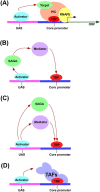Distinct regulatory mechanisms of eukaryotic transcriptional activation by SAGA and TFIID
- PMID: 20800707
- PMCID: PMC3018551
- DOI: 10.1016/j.bbagrm.2010.08.009
Distinct regulatory mechanisms of eukaryotic transcriptional activation by SAGA and TFIID
Abstract
A growing number of human diseases are linked to abnormal gene expression which is largely controlled at the level of transcriptional initiation. The gene-specific activator promotes the initiation of transcription through its interaction with one or more components of the transcriptional initiation machinery, hence leading to stimulated transcriptional initiation or activation. However, all activator proteins do not target the same component(s) of the transcriptional initiation machinery. Rather, they can have different target specificities, and thus, can lead to distinct mechanisms of transcriptional activation. Two such distinct mechanisms of transcriptional activation in yeast are mediated by the SAGA (Spt-Ada-Gcn5-Acetyltransferase) and TFIID (Transcription factor IID) complexes, and are termed as "SAGA-dependent" and "TFIID-dependent" transcriptional activation, respectively. SAGA is the target of the activator in case of SAGA-dependent transcriptional activation, while the targeting of TFIID by the activator leads to TFIID-dependent transcriptional activation. Both the SAGA and TFIID complexes are highly conserved from yeast to human, and play crucial roles in gene activation among eukaryotes. The regulatory mechanisms of eukaryotic transcriptional activation by SAGA and TFIID are discussed here. This article is part of a Special Issue entitled The 26S Proteasome: When degradation is just not enough!
Copyright © 2010 Elsevier B.V. All rights reserved.
Figures



References
-
- Roeder RG. The role of general initiation factors in transcription by RNA polymerase II. Trends Biochem. Sci. 1996;21:327–335. - PubMed
-
- Lee TI, Young RA. Transcription of eukaryotic protein-coding genes. Annu. Rev. Genet. 2000;34:77–137. - PubMed
-
- Roeder RG. Transcriptional regulation and the role of diverse coactivators in animal cells. FEBS Lett. 2005;579:909–915. - PubMed
-
- Ptashne M. How eukaryotic transcriptional activators work. Nature. 1988;335:683–689. - PubMed
Publication types
MeSH terms
Substances
Grants and funding
LinkOut - more resources
Full Text Sources
Molecular Biology Databases
Research Materials

